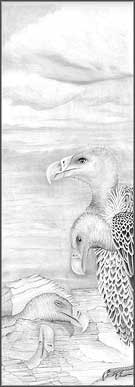|
||||||||||||||||
|
|
||||||||||||||||
|

Humans, Nature and Birds |
From Room 1: From Public to Virtual Venues |
||||
|
|||||
 |
Short-Term Exhibits for Academic Use Since the early 1990s hundreds of thousands of healthy-looking vultures in India had dropped dead. The cause of death appeared to be scavenged food contaminated with diclofenac, a nonsteroidal anti-inflammatory drug that is given to livestock and tends to concentrate in their liver and kidneys. Autopsies showed that the internal organs of 85 percent of the dead vultures had a buildup of uric acid crystals, usually a telltale sign of kidney failure. The same birds tested positive for diclofenac. This was the first record linking wildlife losses to a veterinary drug. Those losses were significant: in the twelve years between 1992 and 2004. Oriental White-backed Vultures (Gyps bengalensis; shown here) had declined by more than 99 percent, and Long-billed Vultures (G. indicus) by 97 percent. After a slow start, steps were taken to phase out the drug and establish a captive breeding program to rebuild |
||||
Plate 64 Vultures and Crystals Oriental White-backed Vultures (Gyps bengalensis), © 2004/2007 Darryl Wheye.Science Art--Birds
|
|||||